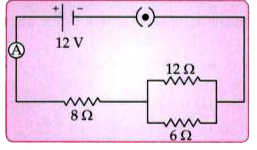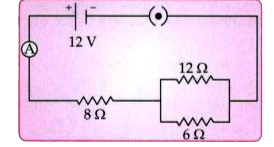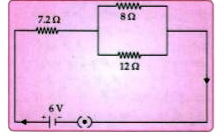A metallic resistor is connected across a battery.If the number of collisions if the free electrons with the lattice is somehow decreased in the resistor (for example,by cooling it ),the current will
(a)increase
(b)decrease
(c ) remain constant
(d) become zero
The correct Answer is:A
To solve the question about the effect of decreased collisions of free electrons with the lattice in a metallic resistor connected to a battery, we can follow these steps:
1. Understand the Concept of Drift Velocity:
- In a metallic conductor, free electrons move through the lattice structure of the metal. The movement of these electrons is affected by collisions with the lattice ions. When the number of collisions decreases, the drift velocity of the electrons increases.
2. Relate Drift Velocity to Current:
- The current (I) flowing through a conductor can be expressed by the formula:
I=n⋅e⋅A⋅vd
where:
- I = current
- n = number of charge carriers per unit volume
- e = charge of an electron
- A = cross-sectional area of the conductor
- vd = drift velocity of the electrons
3. Analyze the Effect of Decreased Collisions:
- If the number of collisions decreases (for example, by cooling the resistor), the drift velocity vd will increase. Since the current is directly proportional to the drift velocity, an increase in vd will lead to an increase in current I.
4. Conclusion:
- Therefore, if the number of collisions of free electrons with the lattice decreases, the current will increase.
Final Answer:
The current will increase (Option A).
---
- In a metallic conductor, free electrons move through the lattice structure of the metal. The movement of these electrons is affected by collisions with the lattice ions. When the number of collisions decreases, the drift velocity of the electrons increases.
- The current (I) flowing through a conductor can be expressed by the formula:
I=n⋅e⋅A⋅vd
where:
- I = current
- n = number of charge carriers per unit volume
- e = charge of an electron
- A = cross-sectional area of the conductor
- vd = drift velocity of the electrons
- If the number of collisions decreases (for example, by cooling the resistor), the drift velocity vd will increase. Since the current is directly proportional to the drift velocity, an increase in vd will lead to an increase in current I.
- Therefore, if the number of collisions of free electrons with the lattice decreases, the current will increase.
The current will increase (Option A).
Topper's Solved these Questions
- ELECTRIC CURRENT IN CONDUCTORSBOOK - HC VERMA ENGLISHCHAPTER - ELECTRIC CURRENT IN CONDUCTORSEXERCISE - objective 2
9 Videos
- ELECTRIC CURRENT IN CONDUCTORSBOOK - HC VERMA ENGLISHCHAPTER - ELECTRIC CURRENT IN CONDUCTORSEXERCISE - Exercises
84 Videos
- ELECTRIC CURRENT IN CONDUCTORSBOOK - HC VERMA ENGLISHCHAPTER - ELECTRIC CURRENT IN CONDUCTORSEXERCISE - worked out Example
33 Videos
- DISPERSION AND SPECTRABOOK - HC VERMA ENGLISHCHAPTER - DISPERSION AND SPECTRAEXERCISE - Question for short Answer
6 Videos
- ELECTRIC CURRENT THROUGH GASESBOOK - HC VERMA ENGLISHCHAPTER - ELECTRIC CURRENT THROUGH GASESEXERCISE - Short answer
6 Videos
Similar Questions
Knowledge Check
A battery of emf 15 V and internal resistance of 4Ω is connected to a resistor. If the current in the circuit is 2A and the circuit is closed. Resistance of the resistor and terminal voltage of the battery will be
A2.5Ω,6VB3.5Ω,6VC2.5Ω,7VD3.5Ω,7V
Three resistors are connected to a 6 V battery as shown in the figure
Calculate:
total current in the circuit.
View SolutionA resistor of resistance R is connected to an ideal battery. If the value of R is decreased,the power dissipated in the resistor will
View SolutionA resistor of resistance R is connected to an ideal battery. If the value of R is decreased,the power dissipated in the resistor will
View SolutionA current of 2A flows through a 2Ω resistor when connected across a battery. The same battery supplies a current of 0.5A when connected across a 9Ω resistor. The internal resistance of the battery is
View SolutionA current of 2A flows through a 2Ω resistor when connected across a battery. The same battery supplies a current of 0.5A when connected across a 9Ω resistor. The internal resistance of the battery is
View SolutionThree resistors are connected to a 12 V battery as shown in the figure given below :

What is the current through the 8 ohm resistor ?
View SolutionThree resistors are connected to a 12 V battery as shown in the figure given below :

What is the current through the 6 ohm resistor ?
View Solution
